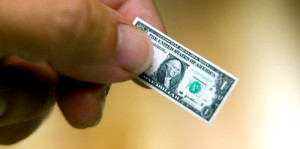
No, no, no… That’s not what I meant by micropayment!
Alright, for today’s Web Wednesday article, I’m going to go a bit off-script.
Normally, I try to make each post as helpful as possible, giving you one incredibly valuable marketing lesson you can apply right away to build your business.
But I’ve been doing some research into selling music — specifically, song singles — and I’ve run into a barrier. And I’m writing this maybe to get insight from you, my reader. Or simply to put my grievance out into the world, for any entrepreneurially-minded person who is looking for a big problem to solve.
My barrier is in something called…
“Micropayments.”
If you’re not familiar with the term, it’s become the lingo for a financial transaction ranging from a few pennies up to maybe $10, give or take.
These are payments that are small enough that the standard payment processing fees of $0.30 + 2.9% (or whatever the percentage is) become relatively expensive. Not because you can’t afford to pay 2.9% to get a payment processed — but because that $0.30 is already over 30% of the purchase price of a $0.99 song (or app, or ebook, or whatever).
Meaning your payment processing fee for a $0.99 song ends up costing you upwards of 35% of your revenue!
Now, I’m used to selling really expensive things. I like to sell $5,000 coaching programs, and $10,000+ copywriting projects. For these, $0.30 added to the payment processing is a miniscule amount.
But if I want to flip that on its head and start offering a $0.99 download, I have to be ready to give up over one third of my revenue just to GET my money…
Never mind business administration costs, web hosting and digital product delivery, shopping cart fees, advertising expenses, and eeking out a little profit…
For music, the common answer is to let someone else sell it…
There are a few places around that charge less than 35% to sell music singles. And the same applies, I’m sure, to platforms to sell other items that would qualify as needing these micropayments.
But the big problem here comes from who controls the customer.
What you give up in exchange for getting a bigger chunk of each sale is intelligence on your customer file. Every service I’ve found so far that lets you sell a $1 item without these exhorbitant payment processing charges does so by keeping the customer within their platform.
Meaning, if I want to know who bought Song X so I can give them special notice of Song Y coming out, I don’t have an easy way to do this.
If I want to have this intelligence on my database of customers, I have to keep them in a system that requries the higher payment processing expense.
There is one possible solution I’ve discovered…
PayPal, a solution or just more confusion?
PayPal, who I do use for a lot of payment processing, does have a potential solution.
They have information about a micropayments rate of 5% plus $0.05 that they offer. Which works out to about 10% of a $0.99 music track, and a good deal (relative to other payment processing fees) on anything up to about $11.90.
But this may be a loss leader at best, or a bait and switch technique at worst.
Because, as it appears from substantial research, you have to switch your ENTIRE account over to micropayments.
Which means suddenly that $5,000 transaction that would have generated $145.30 in payment processing fees at 2.9% + $0.30… Now costs $250.05 in payment processing — over $100 more!
It takes a ton of predictive math to figure out which of these is the best option for your business, depending on the volume you expect at different price points.
A potential solution is to simply set up a different PayPal account, but even that is troublesome. Because PayPal’s stated policy is to only allow one business and one personal account per user. Meaning a separate account at the micropayments rate could end up getting ALL your accounts shut down for violating their terms of service.
This whole either/or thing leads me to believe that PayPal actually loses money on this micropayments rate, and hopes to make it up by charging that 5% on the occasional much bigger transaction.
Which all begs the question…
What’s the solution for micropayments?
To some degree, I’m hoping there’s an answer for ME out there.
But, bigger picture, this is a clear pain point in the marketplace. The more research I do, the more I realize there’s an entire digital economy built on items sold for under $10 that would benefit from the major disruption of a better solution coming online.
Something that easily integrates with existing merchant solutions, that would make both micropayments and regular payments affordable for the same merchant, in the same account.
I don’t know.
Do you have experience with micropayments? A preferred vendor I may have missed?
Please leave a comment below if you have any insight or experience.
Yours for bigger breakthroughs,
Roy Furr
Editor, Breakthrough Marketing Secrets



